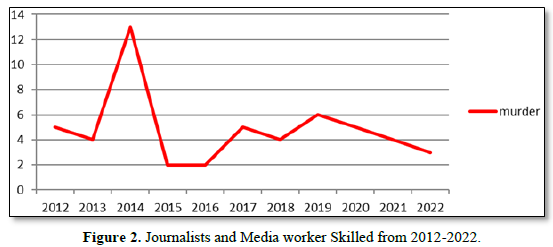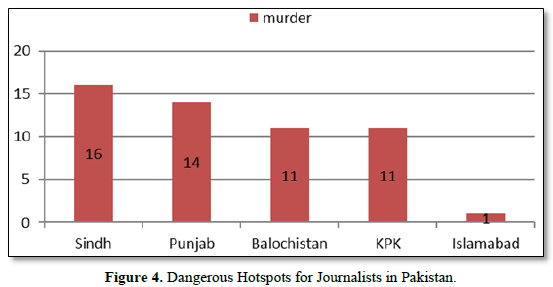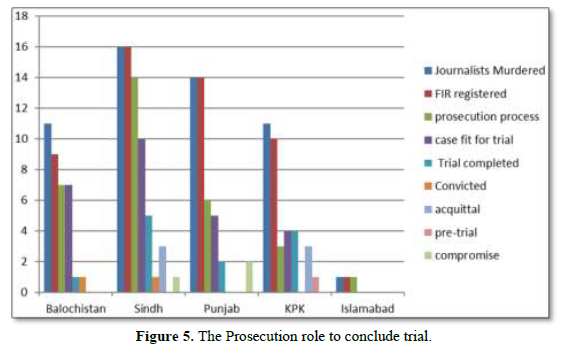1802
Views & Citations802
Likes & Shares
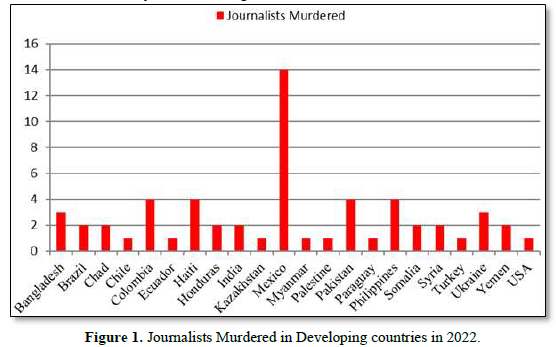
According to Figure 1 in the FIJ 2022 report, Pakistan was ranked 2nd including Colombia, Haiti and Philippines in the world ranking list for worst countries where the journalists were murdered. This ranking underscores the significant risks and dangers journalists face while carrying out their professional duties in Pakistan, highlighting the urgent need for measures to protect their safety and uphold press freedom.
Pakistan Journalists and Media workers killed (2012-2022)
According to Figure 2, from January 2012 to December 2022, Pakistan witnessed an alarming average of approximately five media professionals, comprising journalists and others, losing their lives each year. The year 2014 marked the deadliest period, recording the tragic deaths of 13 journalists and media personnel. These fatalities were distributed across various regions of the country and encompassed two separate incidents in Karachi, where militant groups targeted DSNG vans of different media organizations, resulting in the unfortunate loss of four media practitioners in total [4].
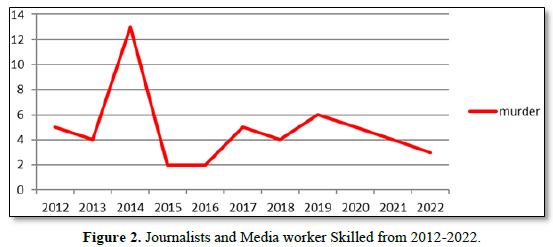
According to Figure 3 the total of 53 journalists lost their lives in Pakistan while carrying out their journalistic duties. Among these, 31 journalists were primarily associated with print media, either exclusively or in addition to other roles, while 23 were mainly involved in TV journalism, again either exclusively or alongside other positions. Additionally, four journalists primarily worked in the digital media sector, and two were associated with radio broadcasting. The reason for the subtotals exceeding the total count of 53 is that some journalists held multiple positions across different media platforms and were thus counted separately within each media category. This includes seven journalists, with six of them working simultaneously in both print and TV media, and one journalist involved in both TV and radio journalism [5].
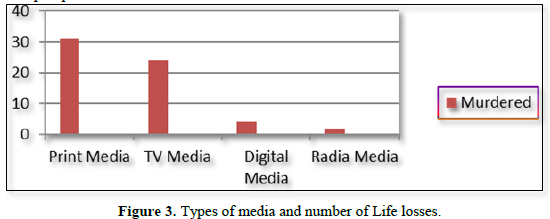
By virtue of Figure 4:
Sindh: Approximately 30% of the journalist fatalities took place in Sindh, making it the most perilous region in terms of journalism practice in Pakistan when looking at percentages.
Punjab: Around 26% of the journalists who were murdered in Pakistan hailed from Punjab, marking it as the second most hazardous region for journalism, percentage-wise. It's noteworthy that one in every four journalists killed in Pakistan comes from this densely populated region, which also has the highest number of journalism practitioners.
Baluchistan: Roughly 21% of the journalist fatalities occurred in Baluchistan, making it statistically tied for the third riskiest region for media practice in Pakistan. This indicates that one out of every five journalists killed in Pakistan comes from a region with the fewest number of journalists in the country.
KPK: About 21% of the documented journalist fatalities were recorded in KPK, making it percentage-wise nearly as dangerous as Baluchistan for journalists.
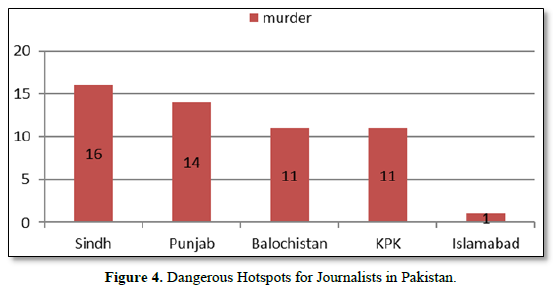
Final status of the court trials of Journalist’s murder (2012-2022)
As per Figure 5 The fifty-three journalists were murdered from 2012 to 2022 Out of the 53 journalists only 12 cases were resulted the completion of trials. Shockingly, in just two of these cases (approximately 17%); the accused killers were convicted for their crimes. In half of the cases (50%), the accused were acquitted, and in a quarter of the cases (25%), the families of the victims reached out-of-court settlements with the accused, effectively allowing them to avoid any legal consequences for their actions. In one case (around 8%), a high court ordered a re-trial following an appeal of neither an acquittal, resulting in neither a conviction nor any further acquittals. It's worth noting that the convictions and punishments of the accused individuals occurred only in Baluchistan and Sindh, with no such outcomes reported from Islamabad, KPK, or Punjab. On the other hand, all six acquittals happened in KPK and Sindh (three each), while instances of out-of-court settlements were reported from Punjab (two cases) and Sindh (one case). Furthermore, a re-trial case emerged in KPK [4]. The failure of the Pakistan’s state to ensure justice for murdered journalists and their families is evident in several stages of the legal process. Initial police investigations are often incomplete, with one in five murdered journalists in Pakistan never seeing their case go to court due to this inadequacy. Out of the 53 journalists murdered between 2012 and 2022, only 31 cases had a preliminary investigation thorough enough to be transferred to court, while nine cases lacked even a final investigation report. Moreover, less than half of the cases investigated by the police progressed to the trial stage, leaving many journalists without the hope of justice. The level of impunity is staggering, with only 4% of the murders resulting in convictions, and the majority of cases failing to establish guilt, either due to a lack of evidence or through out-of-court settlements. While Sindh has the highest journalist fatalities in Pakistan, Punjab, Balochistan, and KPK account for the majority of these cases, with Islamabad being relatively safer for journalists, albeit with documented incidents of violence. According to the 'Pakistan Press Freedom Report 2022' by the Council of Pakistan Newspaper Editors (CPNE), four media professionals lost their lives while performing their duties in 2022, highlighting the deteriorating state of media freedom and freedom of expression in Pakistan. The report asserted that the brutal killings of prominent anchor and journalist figures like Arshad Sharif, Athar Mateen and Zia-ur-Rehman Farooqi due to failure of the government and competent autorites like prosecution role in order to justice of murdered of jurnalists in past. However, the tragic death of Sadaf Naeem, a female reporter and journalist, while she was on assignment, highlighted the inadequate safety precautions in place as well as emphasized that the country's media freedom ranking fell to 157th in the world, a 12-point drop from the previous year. Despite a change in government, the report noted that oppressive tactics against media freedom, freedom of expression and information access remained unchanged. Media personnel faced threat; attacks, violence, arrests and harassment, with incidents like the murder of anchor Arshad Sharif raising concerns not only for current journalists but also for those considering a career in the field [6]. On 13 august 2023, senior journalist Jan Mohammad Mahar was fatally shot at close range in a deliberate attack in Sukkur, located in the Sindh Province, resulting in his death (IFJ, 2022-2023). This research focuses on the case study of the murder of veteran journalist Arshad Sharif, which was the most recent killing reported in October 2022 in Kenya.
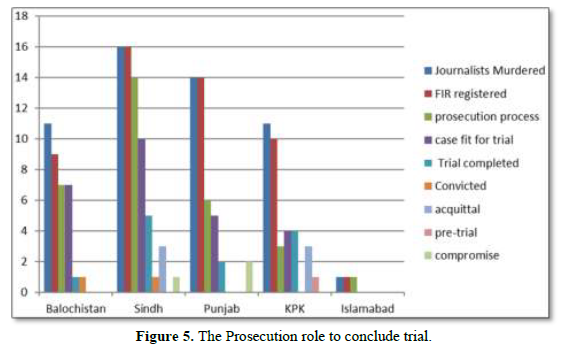
LITERATURE REVIEW
Suzanna MK investigated regarding trauma experiences and exposure to menace that affect mental health condition of journalists in Pakistan. Accordingly, the research is likely to examine how difficulties associated with journalist’s job which could be traumatic in places such as Pakistan results into mental disorders among them. The study aims at elucidating the possible factors and connections which exist between different mental problems and conditions experienced by the workers in this field. The information is relevant because it can help understand how a journalist working under a lot of pressure or stress can get affected mentally. Abida Eijaz [7] examined the numerous problems experienced by media in Pakistan as they entered into 21st century. It might look into changing dynamics, technological developments and sociopolitical determinants of the Pakistani media industry in this period. Moreover, the research paper may suggest some possible remedies or alternatives for dealing with these difficulties with a view to providing an all-inclusive examination of the position and future of Pakistani media in the twenty-first century. This study used an “existing literature review” approach, which covered journalists ‘safety in Pakistan and other parts of the world. There is not much scholarly research on this area though there are numerous reports by many NGOs from various countries worldwide. The Committee to Protect Journalists (CPJ), the International Federation of Journalists (IFJ), International News Safety Institute (INSI), and Reporters Sans Frontiers (RSF) among others produce such reports that are critical in providing understanding and statistics regarding human rights violations against journalists as well as threats to their survival.
Working in the media landscape of Pakistan is fraught with danger for journalists as they undertake their professional responsibilities. It has also been noted that it is more dangerous for journalists based in Khyber Pakhtunkhwa and Balochistan regions compared to other areas because most of these threats are from anonymous sources. Furthermore, these threats involve different entities such as state and non-state actors alike which include; governments, religious extremist organizations, ruling political parties, opposition groups, and law enforcement agencies. The prevailing lack of a robust rule of law, unchecked influence wielded by powerful figures within state institutions, widespread impunity, the financial interests of media owners, and the dire economic circumstances faced by journalists collectively contribute to these alarming threats [8]. According to an annual report covering the period from May 2021 to April 2022, a disturbing total of 86 incidents involving attacks and infringements against the media and journalists were documented in Pakistan. Notably, state actors emerged as the primary source of threat towards journalists. These statistics further indicate that no region within the four Pakistani provinces can be considered safe, along with the federal capital, Islamabad, standing out as the most hazardous location for journalists in the country (PT, 2022).
CONCEPTUAL FRAMEWORK
Social Responsibility Theory (SRT)
The Social Responsibility Theory, a normative press theory, was formally introduced by Siebert, Peterson, and Schramm in 1956 in their publication 'Four Theories of the Media.' This ethical theory places a strong emphasis on the freedom of the press while advocating for journalists' commitment to core values and principles, including impartiality, honesty, and truthfulness. The theory underscores the idea that freedom of the press should be accompanied by a sense of responsibility. In doing so, it ensures the dissemination of fair, unbiased, and accurate information and safeguards fundamental human rights like freedom of speech. This study examines the reasons behind the killings of journalists in Pakistan, particularly in light of the recent tragic murder of the experienced journalist Arshad Sharif in Kenya. It does so by analyzing these incidents through the perspective of the Social Responsibility Theory.
Critical Discourse Analysis (CDA)
There are many ways of looking at the language with regard to power, and this is what CDAs help in doing. The researchers are talking about discourse here, in other words, how researchers talk about things and make sense of them. For any textual analysis to be done someone has to see how different people from different backgrounds use the language across various contexts; he or she must also infer on its affiliation to power. This implies that from our activities, it follows a certain way in which society works so we have to study such patterns using discourse analytic tools. One key objective of employing discourse analysis is to identify which discourses within a text enjoy support from societal institutions and thus have the potential to exert a significant cultural influence. In simpler terms, discourse analysis seeks to investigate how language constructs and shapes our perception of the world [9].
The model of CDA primarily employed in textual analysis, was developed by Norman Fairclough with the aim of conducting both micro and macro-level analyses of discourses [10]. This model serves as a framework for investigating a specific social phenomenon from three distinct perspectives: the text itself (description), the practices within the discourse (interpretation), and the discursive events as manifestations of sociocultural practices (explanation). The "text" phase of analysis focuses on the formal aspects of the text, entailing the description of discourse through the examination of spoken or written language. These tools encompass elements such as interactional control, ethos, metaphors, wording, and grammar. This study is also using the Fairclough’s model of criticalx discourse analysis to examine tweets.
METHODOLOGY
A case study allows for an in-depth examination of a genuine problem situated in a specific context, drawing from a diverse range of data sources. Case study research is a valuable research approach employed primarily when a comprehensive and detailed analysis is required, enabling the examination and comprehension of complex issues. In the case study involving the late Arshad Sharif, data is gathered through in-depth study of research articles, News, Case study and analysts affiliated with both national and international media organizations, employing the snowball sampling technique. Additionally, the written, spoken, and visual components present in the text encompassing the ten most recent tweets by the slain journalist Arshad Sharif before his tragic death are subjected to analysis using the framework of critical discourse analysis (CDA) as outlined in Rizwan S, Asim I, Noor R, and Hussain S [8].
CASE STUDY OF ARSHAD SHARIF
Late Arshad Sharif was a renowned investigative journalist, news anchor and analyst. From 1999 he contributed his expertise to various media organizations, including weekly publications like Pulse and daily newspapers like The News and Dawn. He also played significant roles at Aaj News TV, Dunya News TV and ARY News Channel. Earlier assuming the position of bureau chief at ARY News Islamabad, Arshad Sharif served as the director of news at both Dunya News and Aaj News. His career in television began with hosting the political show 'Kyun' on Dunya News, later transitioning to Dawn News to host 'News Reporter.' Ultimately, he became affiliated with the ARY media group, where he gained widespread recognition for his influential news talk show 'Power Play.' Additionally, he maintained a presence on YouTube with his channel 'Arshad Sharif Official.' Arshad Sharif accumulated more than two decades of professional experience and in recent years, was known for his critical perspective on Pakistan's influential military establishment [11]. Arshad Sharif initially aligned himself with Imran Khan and the PTI while expressing opposition to the PMLN. However, his stance shifted before Imran Khan's removal from the position of prime minister, as he began to voice criticism against the Pakistan army's involvement in these events. Tragically, in October 2022, he was fatally attacked in Kenya while living in self-imposed exile. The slain journalist Arshad Sharif was a vocal opponent of the political transitions within Pakistan. In August 2022, he left Pakistan due to accusations of subversion, which alleged that he had criticized state institutions and supported dissent within the military. He was an ex-passionate journalist, who first used to support the ideas of former Prime Minister Imran Khan and those of the ruling junta. Nevertheless, he later changed his career from journalism to political activism, producing unilateral stories. When establishment softened its position towards government Sharif refused to change his attitude which in turn made him leave the country. Therefore it was not clear whether he was being punished for his journalism or for his own personal ideology, as such this firm standpoint is seen as anti-journalism. Before now he was perceived as one who supports PTI Chairman Imran Khan’s narration and had a good rapport with the establishment. However, his deep immersion in ratings changed that aspect of his life and made him relinquish journalism at the end of which he left the country thus exposing himself to several threats like foreign agencies having interest in damaging Pakistan’s image. . Sharif flew after he decided to toe Khan’s narrative for the sake of ratings hence resulting into FIRs against him that some people attribute it to establishment or government. While FIRs against journalists are not uncommon in Pakistan, Sharif's case seemed to be more significant due to the damage his criticism could inflict on institutional credibility, especially considering his previous close ties to the establishment [8].
Arshad Sharif: Journalist to PTI Campaigner
The late Arshad Sharif, a legendary journalist, demonstrated a clear political bias toward the prominent Pakistani political party, PTI, and its leader, Imran Khan. At times, he even assumed the role of a spokesperson for Imran Khan. Despite his previous reputation as one of the top investigative journalists, he abandoned his journalistic neutrality to become an activist for the PTI. He became a close advisor to Imran Khan and openly promoted him through his television programs. This unwavering stance had consequences and it remains unclear whether he met his demise due to his journalistic work or his activities on social media, such as v-logs and other posts [12]. The flow of information on social media is predominantly one-sided, lacking proper checks and balances. In contrast, journalism operates with various gatekeepers, resulting in a significantly different information ecosystem. Social media has democratized and decentralized information, effectively bypassing traditional gatekeeping processes. This has led to the dissemination of partial, uncontrolled, and occasionally fake news, as there is no effective monitoring of the information flow. A social media activist often takes on multiple roles, serving as an editor, reporter, and more. Arshad Sharif was highly associated with the PTI to the extent that he used to deliver speeches at their events. During a regime change, he was among the journalists who supported PTI's stripe rather than the establishments, primarily due to their strong presence on social media. This alliance with PTI helped boost their profile, ratings, and the reach of their tweets and v-logs, which garnered millions of views and likes. Consequently, Arshad Sharif chose to maintain his alignment with PTI's stance. However, it is important to note that a journalist is expected to remain unbiased. In this case, Arshad Sharif's alignment with PTI went beyond mere personal convictions; he was following the directives of external power segments. This resulted in him no longer being an independent journalist but rather a committed worker for PTI, a shift that was unnecessary. His inclination towards the party extended to the point of effectively joining their faction
Arshad Sharif's Evolving Narrative on Establishment and Regime Change
Arshad Sharif, prior to his untimely demise, was actively crafting a narrative that opposed the establishment in Pakistan. His perspective shifted from initially condemning the corruption within the leadership of PMLN and PPP to supporting them after a change in government, suggesting a possible acceptance of their corruption. Previously considered a mouthpiece for the establishment, he underwent a transformation, becoming more critical and outspoken against them. One of the central themes in Sharif's evolving narrative was the notion that democracy in Pakistan was never truly free but constantly under the influence and control of the military establishment. He propagated the idea that the change in government under Imran Khan's leadership was orchestrated by external forces, particularly the United States. He also endorsed the "cypher conspiracy" theory, asserting that the military establishment was complicit in this alleged covert operation [13]. Sharif's stance became notably anti-establishment, and he aligned himself closely with Imran Khan, actively reinforcing this perspective. He constructed a binary narrative where one political party was portrayed as corrupt while the other was depicted as honest. Furthermore, he believed that the force responsible for bringing the "corrupt" party back to power was equally undesirable. His mission appeared to be opposing the regime change in Pakistan, as he argued that the country's institutions were unduly influencing democracy. In the process, he tarnished the image of these institutions. In the lead-up to his tragic death, he vocally asserted that the establishment should not dictate what journalists’ report, despite having received support from these institutions in the past. He also engaged in political targeting by calling out the Chief of Army Staff by name, turning the situation into a political battleground and making declarations in favor of an elite fight. However, it is essential to note that his death cannot definitively be attributed to his narrative. While his evolving stance and confrontations with powerful figures created a contentious environment, the exact reasons behind his demise remain uncertain.
Role of Competent Authority in the Case of Arshad Sharif
The Supreme Court of Pakistan has taken Suo Motu notice of the tragic killing of senior journalist Mr. Arshad Sharif, causing widespread sorrow and unrest in the journalist community. The murder's condemnation led to numerous requests for the Apex Court's intervention in ensuring justice in accordance with the Constitution. Responding to public sentiment, the Honorable Chief Justice entrusted the Human Rights Cell of the Supreme Court with conducting an inquiry. Subsequent recommendations by Honorable Mr. Justice Ijaz Ul Ahsan and Honorable Mr. Justice Muhammad Ali Mazhar, a Suo Motu case was convened, with directives issued after the December 6, 2022 hearing for the submission of the Fact-Finding Committee's report, FIR presentation, and a report on the Kenyan investigation by December 7, 2022, at 12:30 pm (https://www.supremecourt.gov.pk). On December 6, an FIR (First Information Report) was filed by Pakistan police at Islamabad's Ramna Police Station against Waqar Ahmed, Khurram Ahmed, and Tariq Ahmed Wasi under the directive of the Supreme Court. The FIR includes charges under sections 302 (related to punishment for murder) and 34 (pertaining to acts done by multiple individuals with a common intention) of the Pakistan Penal Code. Tariq Wasi, the CEO of Karachi Kings, had previously been identified in the investigation as the individual responsible for sponsoring Arshad Sharif's Kenyan visa. The Supreme Court had ordered the government to file this FIR by the evening of December 6 (https://www.ifj.org/media-centre/news/detail). On December 8, an investigative team comprised of two officials from the Intelligence Bureau and the Federal Investigation Agency completed their inquiry, determining that the killing of senior journalist Arshad Sharif on October 23 was a deliberate assassination, purportedly involving individuals with international connections (https://www.ifj.org/media-centre/news). The IFJ said: “The ongoing investigations into the killing of Arshad Sharif are an important step in combatting impunity for crimes against journalists and media workers. In their analysis, the investigative team identified significant inconsistencies in the accounts provided by Kenyan General Service Unit (GSU) officers regarding the circumstances of Arshad Sharif's death. The report suggests that these GSU officers, who were present at the scene, may have been complicit in the conspiracy for economic or other motives. The report also confirmed that Arshad Sharif had not experienced any form of torture before his death based on police reports and autopsy findings. However, it did indicate that the fatal gunshot that caused Sharif's death likely originated from close range or inside the vehicle.
Role of the Public Prosecution in Arshad Sharif Case
The judicial magistrate in Islamabad has stopped the murder case of journalist Arshad Sharif due to the absence of any prosecution witnesses at the trial proceedings. The judge took the step of issuing non-bailable arrest warrants to all prosecution witnesses, including Arshad Sharif's wife. These warrants were issued because none of the witnesses had appeared in court on the proper date in order to recording the evidence. The judge cited that prosecution's apparent is the lack of interest regarding the recording of the evidence in order to concluded the case. According to the court order, the prosecution had been given more than fifteen opportunities in ordr to present their evidence, yet they consistently failed to do so. The court order also mentioned that the public prosecutor acknowledged in his statement that both private and official witnesses were not cooperating [14,15]. The prosecution has failed to fulfill its duty in order to pursuing the case as well as fials to recording the evidence. It is the prosecution's responsibility to diligently handle cases like this, but in this instance, their role appears to be negligible. This situation raises serious concerns about the safety of journalists because if Arshad Sharif could not obtain justice, it sets a precedent that may discourage others from seeking justice in the future. This situation not only jeopardizes the safety of journalists but also undermines the overall pursuit of justice.
Thematic and Critical Discourse Analysis of Tweets by the Late Arshad Sharif (@arsched)
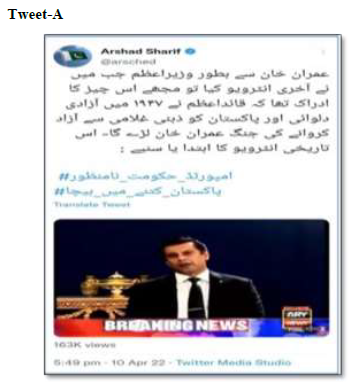
The tweet A late Arshad Sharif contain the notable terms like 'Quaid-i-Azam,' 'Azaadi' (liberty), 'Zehni Ghulami' (intellectual subjugation), and 'Jang' (battle), alongside hashtags 'Imported Hakumat Namanzoor' (Reject Imported Government) and 'Pakistan Kitny me Becha' (At What Cost Was Pakistan Sold). In this tweet, he draws a parallel between Imran Khan's political struggle (Jang) and the historical freedom movement led by Quaid-i-Azam, the Founder of Pakistan. By employing these hashtags, he advocates for the political narrative associated with the ousted Prime Minister Imran Khan. The term 'Imported Hakumat' alludes to Imran Khan's claim that the opposition government was established with foreign backing, underscoring a foreign conspiracy against his administration. Consequently, the primary theme in this tweet revolves around the idea of 'regime change' influenced by foreign factors.

The tweet-B includes references to being released on bail, facing money laundering allegations, having an ongoing inquiry and being accused of corruption. Similarly, in the this tweet, Arshad Sharif poses the same question to President Arif Alvi, inquiring whether he would administer the oath of Prime Minister to an individual who is currently out on bail for money laundering accusations. In this instance, the late journalist highlights the alleged corruption of PDM's Prime Minister candidate, Shehbaz Sharif. Therefore, the central themes in these tweets revolve around opposition to the PDM (Pakistan Democratic Movement) and the issue of corruption.

The Tweet-by the late journalist Arshad Sharif includes references like 'Adhi raat adalat' (court at midnight), 'bunyadi haqooq per daka' (attack on fundamental rights), 'qomi salamti ka masla' (national security issue), along with hashtags 'Imported Hakumat Namanzoor' (Reject Imported Government) and mentions the Supreme Court of Pakistan. This tweet also prominently touches upon the themes of 'regime change' and 'foreign conspiracy.' This is evident from the mentioned codes such as the court convening late at night, violations of fundamental human rights, concerns related to national security, and the presence of the two hashtags. In these tweets, Arshad Sharif sheds light on the 'political discourse' associated with Imran Khan.

"I am a Pakistani citizen and the custodian of Pakistan. I promised that I will use all my strength against any individual or organization, whether internal or external, that acts against the interests of this country or violates its laws.

Tweet-Eauthored by Arshad Sharif exhibited a significant level of involvement, as they often glorify a particular political party's ideology through expressions of obligation and duty. Moreover, the Chief of Army Staff is addressed by name and subjected to inquiries regarding corruption, while the Prime Minister is frequently subjected to humiliation through expressions of uncertainty and knowledge. The most commonly employed terms in these tweets are Imran Khan, DGISPR (Director General of Inter-Services Public Relations), and COAS (Chief of Army Staff). The tweets analyzed exhibit a high degree of interconnectedness, showcasing a political party's stance in Pakistan while criticizing other parties and their leaders for alleged corruption. They also highlight power dynamics between institutions and political leaders, constructing an anti-establishment narrative. Certain terms are strategically employed to diminish those in power and elevate a party's ideology. The tweets reflect a strong sense of moral duty to oppose regime change. The primary audience for these discourses is the people of Pakistan, aligning with the journalist's social responsibility to contribute to the public interest while adhering to journalistic ethics.
CONCLUSION
Journalism in Pakistan is not only multifarious, but at the same time a very difficult area for journalists who continually face high risks and difficulties as they carry out their professional duties. The present study examines multiple aspects of journalist safety in Pakistan, with an emphasis on the assassination of Arshad Sharif-a well-known journalist. Pakistani journalists confront different perils such as criminal gangs, unknown criminals and sometimes even state authorities while reporting news or seeking some stories. Despite these hurdles; however, their dedication to delivering correct and vital news to their public demonstrates the bravery and commitment required by their calling. The research explores the basic principles as well as actors behind the killings of journalists in Pakistan, thereby exposing what is faced by people who work in media. At the same time, it examines how such a system can put at risk their safety. In this regard; therefore, this study particularly focuses on Arshad Sharif, a journalist who died tragically. This extensive scrutiny is meant to untangle much more complicated threads surrounding journalist murders in Pakistan and explain peculiarities and systemic problems inherent in the job. Also, CDA was used to analyze ten most recent tweets of Arshad Sharif to uncover their underlying themes and the rhetorical strategies used in them. Moreover, the research demonstrates how the prosecution has failed in prosecuting those who commit crimes against journalists in Pakistan particularly on cases The ordeal of Arshad Sharif’s death is a vivid illustration of the problems faced by Pakistani journalists. This murder has ignited concerns about the welfare of media personnel and ethical lapses within Pakistan journalism.
- Akhtar N, Pratt CB (2017) Pakistani government-news media relationships: How relevant are Western journalistic values? Journal Stud 18(1): 65-85.
- Høiby M, Ottosen R (2019) Journalism under pressure in conflict zones: A study of journalists and editors in seven countries. Media War Conflict 12(1) 69-86.
- Amin S, Shahwar D, Shabir G, Ali S (2022) Governance Corruption and the Media: Reflection of Corruption during the PML-Q and PML-N Political Regimes. Elem Educ Online 19(4): 5586-5586.
- Rehmat A, Naeem W (2022) Impunity of Crimes Against Journalists Pakistan Report 2022. Available onilne at: https://www.fnpk.org/wp-content/uploads/2022/10/FINAL-Impunity-Report-2022.pdf
- PakistanSlider (2022) No Convictions in 96% of Journalist Killings in Pakistan: FN Impunity Report 2022. Available onilne at: https://www.fnpk.org/no-convictions-in-96-of-journalist-killings-in-pakistan-fn-impunity-report-2022/
- Noor R, Nazir N (2023) Dicing with Death: Analyzing the Killings of Pakistani Journalists with A Focus on Arshad Sharif Case. J ISOSS 9(2): 631-642.
- Eijaz A, Rahman BH, Ahmad RE, Butt JA (2014) Challenges and Options for Pakistani Media in the 21st J Political Stud 21(1): 243-257.
- Hussain S, Ahmad AR (2022) Examining perceptions towards war/peace journalism: A survey of journalists in Iraq, Afghanistan and Pakistan. Int Commun Gaz 84(3): 183-205.
- Fairclough N (2023) Critical discourse analysis. In The Routledge Handbook of Discourse Analysis. Routledge. pp: 11-22.
- Potter J (2012) Discourse analysis. In L. M. Given, the SAGE Encyclopedia of Qualitative Research Methods. Thousand Oaks: SAGE Publications, Inc pp: 218-220.
- Abbas M (2022) Investigating the murder of an investigative journalist. Geo TV. Available onilne at: https://www.geo.tv/latest/448641-investigating-murder-of-investigative-journalist
- Ghauri MJ, Khan MR, Ahmed N (2023) Journalism and the regime change in Pakistan (2022): exploring the solidarity and political discourses on the social media. J Human Soc Manag Sci 4(1): 97-117.
- Jafri (2022) Killing of Arshad Sharif: Why Pakistani journalists are killed? Pakistan Today October 27, 2022. Available onilne at: https://www.pakistantoday.com.pk/2022/10/27/killing-ofarshad-sharif-why-pakistani-journalists-are-killed
- Asad M (2023) Court shelves Arshad Sharif’s murder trial. Dawn. Available onilne at: https://www.dawn.com/news/1777038/court-shelves-arshad-sharifs-murder-trial
- Koster SM, Koot HM, Malik JA, Sijbrandij M (2022) Associations among traumatic experiences, threat exposure, and mental health in Pakistani journalists. J Trauma Stress 35(2): 581-592.
QUICK LINKS
- SUBMIT MANUSCRIPT
- RECOMMEND THE JOURNAL
-
SUBSCRIBE FOR ALERTS
RELATED JOURNALS
- Stem Cell Research and Therapeutics (ISSN:2474-4646)
- Oncology Clinics and Research (ISSN: 2643-055X)
- Dermatology Clinics and Research (ISSN:2380-5609)
- International Journal of Clinical Case Studies and Reports (ISSN:2641-5771)
- International Journal of Surgery and Invasive Procedures (ISSN:2640-0820)
- Journal of Cell Signaling & Damage-Associated Molecular Patterns
- International Journal of Anaesthesia and Research (ISSN:2641-399X)


